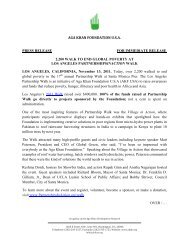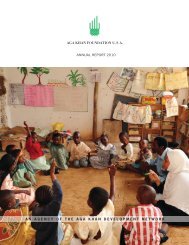2010 Annual Report: Education - PartnershipsInAction
2010 Annual Report: Education - PartnershipsInAction
2010 Annual Report: Education - PartnershipsInAction
You also want an ePaper? Increase the reach of your titles
YUMPU automatically turns print PDFs into web optimized ePapers that Google loves.
school leaving at an early age. It can provoke or reinforce a debilitating<br />
sense of incompetence and failure. A prime question<br />
for both researchers and policy makers has been, “Why do some<br />
children make this transition smoothly and others do not, presumably<br />
with negative effects on their future productivity, well<br />
being and contributions as citizens” Another question is,<br />
“What can we do about it”<br />
Although the emphasis on the perils of moving from preschool to<br />
school and what to do about it characterizes transition concerns<br />
today in the Minority World where most children already attend<br />
preschool, it is the “transition” directly from home to school that<br />
is often the main concern in Majority World countries where the<br />
AKF works, countries in which many children do not have the<br />
chance to attend a preschool before entering primary school.<br />
This is not the place to go into detail about definitional differences.<br />
However, I have put “transition” in quotes because, conceptually,<br />
at least to me, the notion of a transition means not<br />
only moving from one state or condition to another but also, in<br />
the passage, leaving behind the previous condition. This works<br />
for the passing from preschool to school because preschool is<br />
left behind. It does not work so well when talking about the<br />
move from home into school because a child does not leave the<br />
family behind; rather, the movement is back and forth between<br />
two places, each with their own characteristics and demands.<br />
Some have preferred to use the terms “horizontal transition”<br />
(Kagan <strong>2010</strong>) or “border crossing” (Campbell Clark 2000) for<br />
such situations. In these conceptualizations, the emphasis is<br />
placed on relationship(s) among different learning environments<br />
in which a child participates. The question then is not only how<br />
a child adjusts to a new environment (school) and how “continuity”<br />
may be achieved between them so as to facilitate learning in<br />
the new one, but also how the passage may affect development<br />
and learning in the parallel and continuing environment (home,<br />
but perhaps also the community, the child care center, the<br />
church and the media), and how the differential characteristics<br />
of each environment might be drawn upon to best advantage in<br />
each setting, without creating confusion that drags down the development<br />
and learning processes.<br />
The passage from home to school will be emphasized in this article.<br />
In that passage, worries about discontinuities, adjustment<br />
difficulties and effects on learning and life are supposedly magnified<br />
because the differences between home and school settings<br />
are thought to be much greater than differences between preschool<br />
and school environments. Indeed, establishing<br />
preschools is seen as a way of getting closer to school and of<br />
moderating home-school differences, thereby facilitating the<br />
home-to-school transition. A growing literature from the Majority<br />
as well as Minority Worlds suggests that this strategy can<br />
have the desired effects (Kagan <strong>2010</strong>).






